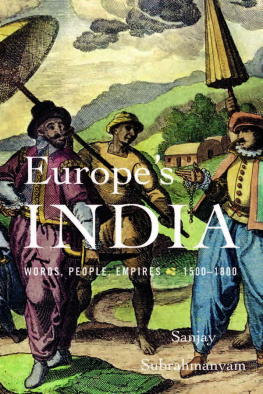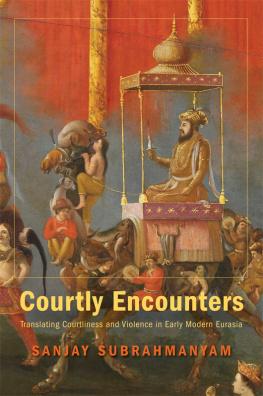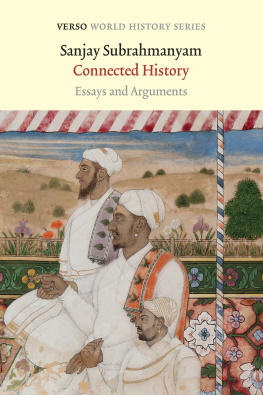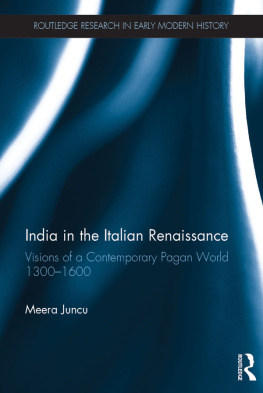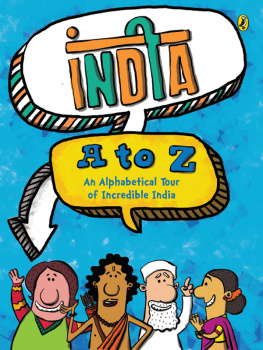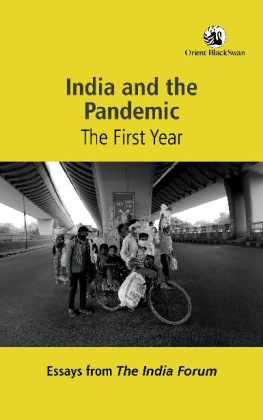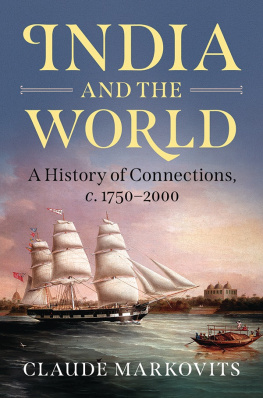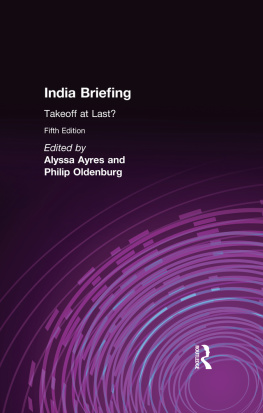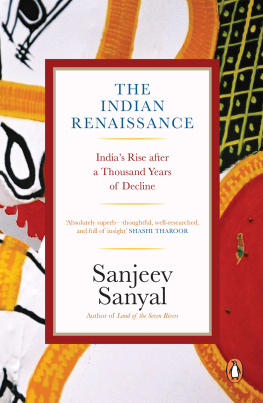EUROPES INDIA
Europes India
WORDS, PEOPLE, EMPIRES, 1500-1800
Sanjay Subrahmanyam

Harvard University Press
Cambridge, Massachusetts
London, England
2017
Copyright 2017 by the President and Fellows of Harvard College
All rights reserved
Printed in the United States of America
First printing
Library of Congress Cataloging-in-Publication Data
Names: Subrahmanyam, Sanjay, author.
Title: Europes India : words, people, empires, 1500-1800 /
Sanjay Subrahmanyam.
Description: Cambridge, Massachusetts: Harvard University Press, 2017. I Includes bibliographical references and index.
Identifiers: LCCN 2016036668 I ISBN 9780674972261 (alk. paper)
Subjects: LCSH: EuropeCivilizationIndic influences. I
IndiaCivilizationEuropean influences. I IndiaForeign public opinion, EuropeanHistory. I EuropeansAttitudesHistory. I OrientalismHistory.
Classification: LCC DS446 S78 2017 I DDC 303.48/240540903dc23
LC record available at https://lccn.loc.gov/2016036668
For Jaivir Singh
CONTENTS
o0o
ABBREVIATIONS
ANOM | Archives Nationales dOutre-Mer, Aix-en-Provence |
ANTT | Arquivo Nacional da Torre do Tombo, Lisbon |
BL | British Library, London |
BnF | Bibliothque nationale de France, Paris |
CC | Corpo Cronolgico |
FRP | Fraser of Reelig Papers, Kirkhill, Scotland |
HAG | Historical Archives, Panaji, Goa |
IESHR | Indian Economic and Social History Review |
NLS | National Library of Scotland, Edinburgh |
OIOC | Oriental and India Office Collections |
PREFACE
Kinder statt Inder (Children in place of Indians): this enigmatic and arresting slogan put forward by a conservative politician was much on peoples minds in the years 2000 and 2001, when I happened to be visiting and learning German in Berlin. It referred to the perceived threat of a mass invasion by educated Indians, armed with degrees in computer science and such, who would arrive in Germany and thereby deprive real Germans of their livelihood. Some timid moves had been made by the German government to give a few visa concessions to computer scientists, and this was the populist reaction: why not make our own baby computer scientists rather than importing them from India? At the same time, as part of a small group of Indians visiting a prestigious academic institution in the German capital over that year, we were also frequently assured of how much middle-class Germans loved India, not only in the abstract and at a distance, but by visiting it regularly, and even by bringing a strange dish called Currywurst into their gamut of fast food, or Imbiss. Allegedly invented after World War II, this dish consisted of pork sausage (or Bratwurst ) topped with tomato paste (or ketchup) and seasoned with some odd form of prefabricated curry powder, which had apparently been obtained from British troops stationed in Germany.
Perhaps the Currywurst was my Proustian madeleine; at any rate it did lead me to the first concrete steps toward this project. But a germ of this book may have existed before then, even if somewhat unconsciously. A couple of years earlier, in May 1998, I found myself in Kozhikode and Kochi (or, if one prefers, Calicut and Cochin) with a varied cast of characters, for a strange event that was ostensibly intended to reflect on the fifth centenary of the arrival of Vasco da Gama in India, and its long-term implications for Europe-India dealings. Each of those presentfrom Amiya Bagchi and Partha Chatterjee to Kesavan Veluthat and Raghava Varierbrought a different perspective and expertise to bear on the reflection, and I continued to mull over the enigma of Europes relations to India in the following years. However, a variety of other projectson historiography, on Indo-Persian travel accounts, on go-betweens and aliens, and so onalways took precedence. Eventually, however, I have managed to clear enough mental space to address this project, and I hope that the gradual mulling over (a process modeled on the winepress, rather than the hothouse) has had a positive effect on the end product.
Some scholars are apparently disciplined enough to organize their lives sequentially, so that one project follows another in orderly fashion. Most, I suspect, are not, and I certainly belong to the latter and quite disorderly category. Since I tend to think about various intellectual projects at once, they sometimes get in the way of one another, and the conflict canat worsteven bring the business of research and writing to a calamitous standstill. The reasonable way around it is to prioritize, and to decide which projects are big and which ones are small, or to place them on front and back burners, at least for a certain time. External deadlines can at times be useful in this respect too, so long as one responds well psychologically to the stimulus of grumpy letters or irate messages from a volumes editor or from a press for whom one has a long-overdue project.
All this is by way of an approach to this book, whose central themesas I noted aboveI may have been thinking about intermittently since at least the late 1990s, when I was also teaching for an extended duration at the cole des Hautes tudes en Sciences Sociales (Paris). I began addressing some of its questions there, as part of my weekly seminar at ii am on Tuesday mornings in 105 Boulevard Raspail, and even spoke casually of the project to one or two publishers, with whom my conversations never extended beyond a vague expression of interest to a firm commitment. My interest was further sparked by co-organizing a two-day conference in early 1998 entitled Doors to Asia, in which some of the themes in this book were discussed by a variety of participants; but I was also probably influenced by some edited volumes that I was given at the time and which had emerged from the Parisian milieu, such as Ulnde et limaginaire (1988) and Rver lAsie (1993).
These reflections eventually led me in turn to think at great length and more systematically about two important works that had appeared at roughly the same time. The first and lesser-known of these was Partha Mitters Much Maligned Monsters (1977), a dense work of considerable originality produced under the supervision of Ernst Gombrich. I have read and reread my copy of this book, and will freely admit that it was in many respects another point of intellectual departure for this one. I was fortunate at much the same time to meet and have discussions with Partha Mitter himself on several occasions, and these meetings became more frequent during the brief time (from 2002 to 2004) when I taught at Oxford and he was navigating between Brighton and Oxford. However, my approach, unlike his, was not primarily from the viewpoint of art history, but as an archive- and text-based historian who also sometimes used images. Nevertheless, despite some differences of method and opinion here or there, it is important for me to note this intellectual debt from the outset.
The other book was far more celebrated and also controversial, namely Edward W. Saids Orientalism (1978). Although this work was already sometimes discussed in Delhi when I was a doctoral student in the early 1980s, its impact there only attained important dimensions in the latter half of the 1980sby which time it had already been elevated to the status of a cult classic elsewhere. Since Said had mainly focused in his work on the Arabic-speaking Orient, it fell in the first instance to two Chicago-based scholars to attempt to apply his insights to India. One of these, Bernard Cohn, did so in a series of essays that was eventually collected as a short book,
Next page
